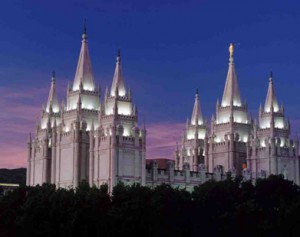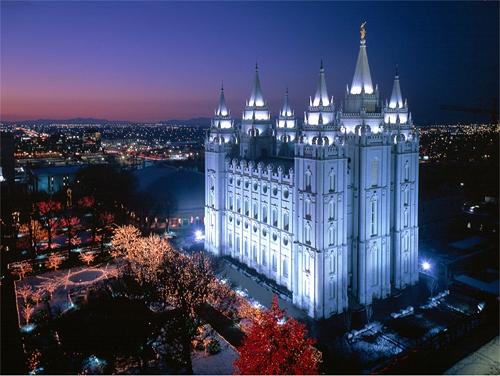One of the key missions of the Mormon Church is to help “perfect the Saints.” In other words, the Church’s goal is to help members (Saints) be as good as they can be. The Church does this by helping members in their struggle to follow the perfect example set by Jesus Christ.
 |
| Salt Lake Temple |
So how do Mormon temples help in this mission? There are two important answers: by providing a holy place apart from the world and through sacred ordinances.
- All Mormon Temples
- Las Vegas Temple
- Los Angeles Temple
- Manhattan Temple
- Newport Beach Temple
- Oakland Temple
- San Diego Temple
A Place Set Apart from the World
Mormon temples are places designed to be “set apart from the world,” thereby creating an atmosphere where God’s Spirit can have greater influence. Those members of the Mormon church who keep minimum standards of conduct and have a strong faith in Jesus Christ are allowed to enter the temple. This is similar to ancient temples, where only those who went through a process of purification were permitted into the inner courts of the temple. As in days gone by, those who have prepared to enter the temple—those who meet the minimum standards—are able to enter and receive the blessings available there. This concept was stated quite clearly by James Faust, a member of the Mormon Church’s First Presidency:
- The days our our lives will be greatly blessed as we frequent the temples to learn the transcending spiritual relations we have with Diety. We need to try harder to be found standing in holy places (James E. Faust, “Standing in Holy Places,” Ensign (May 2005), 67).
To those who are prepared, the Mormon temple is a “holy place” where the Spirit of the Lord can freely dwell. Mormon temples serve as a sanctuary to those who attend them, providing a place that is holy and has been set aside as a house of the Lord. They are places for prayer, thought, reflection, and revelation.
A Place for Sacred Ordinances
 The second way in which temples help to perfect the Saints is through special, holy ordinances that can only be performed within the Mormon temples. Ordinances are symbolic ceremonies performed as a way to signify covenants made between the member and God.
The second way in which temples help to perfect the Saints is through special, holy ordinances that can only be performed within the Mormon temples. Ordinances are symbolic ceremonies performed as a way to signify covenants made between the member and God.
One common temple ordinance in Old Testament times was the sacrificing of an animal to God. The actual sacrificing of the animal did nothing for the people, but was a symbolic reminder of the sacrifice that would one day come through the Lord Jesus Christ. While the need for animal sacrifice was done away with after the death and resurrection of the Eternal Sacrifice, Jesus Christ, the New Testament indicates that ordinances and the covenants they represented did not cease. Matthew 26:26-28 gives us the following account:
- “And as they were eating, Jesus took bread, and blessed it, and brake it, and gave it to the disciples, and said, Take, eat; this is my body. And he took the cup, and gave thanks, and gave it to them, saying, Drink ye all of it; For this is my blood of the new testament, which is shed for many for the remission of sins.” (Matthew 26:26-28)
The apostles ate bread and drank water that were symbolic of the sacrifice which Christ was about to make for them. This same ritual, or ordinance, is practiced by Christians to this day. The ordinance goes by many different names, such as the Eucharist, the Lord’s Supper, or (in the Mormon church) the Sacrament, but it is essentially the same ordinance instituted in New Testament times. Mormon temple ordinances are in keeping with Christ’s higher law, the directive from Him that we should have the commandments and correct principles in our hearts. Thus, temple ordinances consist mostly of instruction and agreement to remember Christ, to serve Him, and to keep His commandments.
Ordinances not only remind us of an event, but additionally are a sign of covenants made with the Lord. A covenant is a two-way promise. When we are baptized we make a covenant with the Lord that we will strive to follow the example of Jesus Christ and repent of our sins. In return, the Lord promises that if we keep our part of the covenant, He will forgive us when we come to Him with our mistakes and a sincere heart, with a real desire to change.
Inside the Mormon temple there are primarily two ordinances performed for the members of the Mormon church. The first of these ordinances is known as the temple endowment, and the second as the sealing ordinance, key to celestial marriage. The first ordinance is designed for individuals, and the second is designed to create eternal families. These ordinances are very sacred and holy, so faithful Mormons don’t discuss their details outside of the temple, even with each other.
Ordinances for Others
Not only are the Mormon temples provided so that ordinances can be done for the living, but ordinances in the temples can also be done for those who are dead. Mormons believe that earthly ordinances must be performed, even for those who are no longer capable of performing those ordinances for themselves. There are billions of people who have lived on this earth without ever hearing the name of Christ, or coming to understand the sacrifice He made for them. Would God be just in judging them when they had no knowledge?
All of the ordinances offered in the temple for living members of the Mormon church are also performed by proxy for those who have passed on. Temple marriage, sealings, and endowments are performed with someone symbolically standing in for the person who is deceased. Baptisms are also performed by proxy for these people who have passed on.
Because we have no way of knowing who will or will not accept the gospel of Jesus Christ, temple ordinances are performed for everyone who has passed on. To have a family member who has passed on baptized by proxy does not commit that deceased person to accept a “Mormon baptism.” Instead, it merely gives that person the opportunity to accept or reject the ordinance as they choose.
More information about Mormon Temples
Temple (Mormonism) – Wikipedia, the free encyclopedia
BBC Religion & Ethics – Mormon Temples
Manhattan Mormon Temple – New York City.com: Arts & Attractions
Temple: Information from Answers.com
Mormon Temple Ordinances – ReligionFacts.com
Mormanity: Mormon Temples and “Secrecy”
History of Mormon Temples – Lightplanet.com
